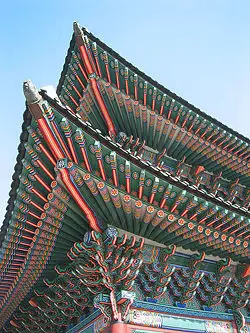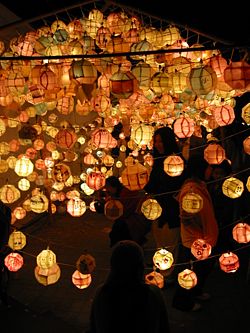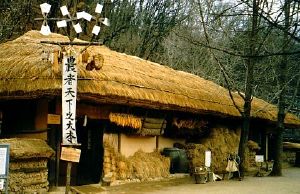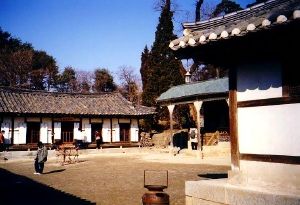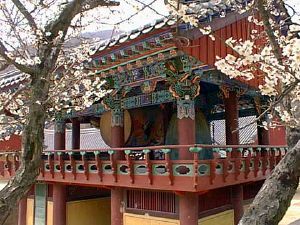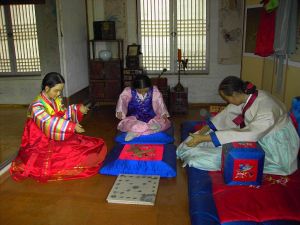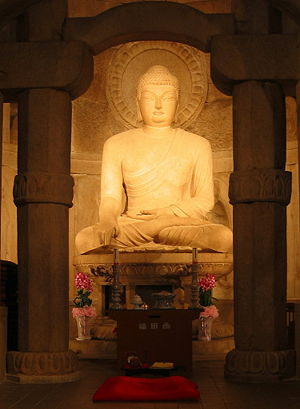Difference between revisions of "Culture of Korea" - New World Encyclopedia
Dan Davies (talk | contribs) m |
Dan Davies (talk | contribs) (→Traditional Korean arts: edit) |
||
| Line 4: | Line 4: | ||
[[Image:Korean architecture roof detail 2.jpg|thumb|250px|[[Joseon dynasty]] court architecture]] | [[Image:Korean architecture roof detail 2.jpg|thumb|250px|[[Joseon dynasty]] court architecture]] | ||
[[Image:Lotus latern festival 2001.jpg|[[Korean Buddhism]]|250px|thumb|Lotus Lantern Festival]] | [[Image:Lotus latern festival 2001.jpg|[[Korean Buddhism]]|250px|thumb|Lotus Lantern Festival]] | ||
| − | + | [[North Korea]] and [[South Korea]] traditionally share the '''culture of Korea''', <ref>See "Same roots, different style" by Kim Hyun : [http://www.korea-is-one.org/article.php3?id_article=2565]</ref>, although the political separation of the two nations has created two, distinct [[Korea|Korean]] cultures. | |
| − | |||
==Traditional Korean arts== | ==Traditional Korean arts== | ||
===Music=== | ===Music=== | ||
| − | + | Traditional [[music]] in [[Korea]] has been based on the [[human voice|voice]], a distinct type reflecting the temperament and history of the Korean people. ''Jeongak'' and ''Minsogak'' make up the two kinds of traditional music: | |
''See also: [[Music of Korea]]'' | ''See also: [[Music of Korea]]'' | ||
====Jeongak==== | ====Jeongak==== | ||
| − | Jeongak | + | Court music, Jeongak has a strong intellectual emphasis, closely related to the [[yangban|literate upper-class]]. Played at an extremely slow pace, with single beats taking as long as three seconds, the beat of Jeongak matches the speed of breathing rather than the heartbeat as in most Western music, creating a contemplative and meditative mood. Jeongak's soft and tranquil tone arises from the non-metallic materials of the traditional instruments. String instruments have strings made of silk rather than wire, while bamboo have been the material of choice for almost all wind instruments. |
| − | |||
| − | |||
====Minsogak==== | ====Minsogak==== | ||
| − | + | [[Korea]]'s folk music, Minsogak expresses a wide variety of moods and emotions closely related to the lives of common people. Unlike Jeongak, the beat of Minsogak matches the heartbeat. As with the Jeongak, Minsogak commonly utilizes improvisation especially in the emotional music. | |
| − | |||
| − | As with the Jeongak, improvisation | ||
====Instruments==== | ====Instruments==== | ||
| Line 28: | Line 23: | ||
Traditional string instruments include [[zither]]s such as the [[gayageum]], [[geomungo]], and [[ajaeng]], and the [[haegeum]], a two-stringed [[fiddle]]. | Traditional string instruments include [[zither]]s such as the [[gayageum]], [[geomungo]], and [[ajaeng]], and the [[haegeum]], a two-stringed [[fiddle]]. | ||
| − | + | Koreans love traditional percussion instruments and have many, including the [[kkwaenggwari]] (hand-held [[gong]]), the [[jing]] (hanging gong), [[buk]] ([[barrel drum]]), [[janggu]] ([[hourglass drum]]), [[bak]] (clapper), [[pyeonjong]] (bell chimes or stone chimes), as well as the [[eo]] (tiger-shaped scraper) and the [[chuk]] (wooden box) | |
====Characteristics==== | ====Characteristics==== | ||
| − | Apart from the instruments used, | + | Apart from the instruments used, improvisation and the lack of breaks between movements characterizes traditional Korean music. ''Pansori'' provides a good example of the latter. A ''pansori'' performance can last for over eight hours during which a single singer performs continuously. Rather than the contrasting of different speeds common in Western music, most traditional Korean music begins with the slowest movement and then accelerates as the performance continues. |
| − | |||
| − | Rather than contrasting different speeds | ||
===Dance=== | ===Dance=== | ||
[[Image:Korean madang nori.jpg|thumb|150px]] | [[Image:Korean madang nori.jpg|thumb|150px]] | ||
| − | The cross-cultural exchanges with [[China]] and within the [[Three Kingdoms of Korea]] produced a large variety of distinctive dances. | + | The cross-cultural exchanges with [[China]] and within the [[Three Kingdoms of Korea]] produced a large variety of distinctive dances. As with music, court dances and folk dances have distinct differences. Court dancers commonly perform ''jeongjaemu'' at banquets while ceremonial dancers perform ''ilmu'' at Confucian rituals. Native dances (''hyangak jeongjae'') and forms imported from China (''dangak jeongjae'') make up ''Jeongjaemu'' while civil dance (''munmu'') and military dance (''mumu'') comprise ''Ilmu''. |
| − | |||
| − | As with music, | ||
| − | |||
| − | |||
| − | + | Religious dances include all the performances at [[shamanism|shamanistic]] [[rite]]s (''gut''). Secular dances include both group dances and individual performances. Many contemporary productions reflecte the traditional choreography of court dances | |
===Folk games=== | ===Folk games=== | ||
| − | |||
| − | '' | + | Shamanistic rites, handed down from one generation to the next, form the core of many folk games, especially the three rites, ''Yeonggo'', ''Dongmaeng'' and ''Mucheon''. A drumming performance, ''Yeonggo'' invokes spirits while ''Dongmaeng'' blesses the harvest and ''Mucheon'' |
| + | evokes the blessing of heaven. Koreans added games to those [[Shamanism|shamanistic]] performances during the [[Three Kingdom Period of Korea]], | ||
| − | + | A number of folk games originated during the traditional twice monthly farmers' fairs including ''[[Ssireum]]'' a traditional form of wrestling, pitching arrows into a pot (''tuho''), and a game of stick-tossing (''jeopo''), swing riding (''geunetagi''), masked dance drama, and a ball game (''gyeokku''). A more maritial game, stone fights (''seokjeon'') caught the interest of the young men of the villages. In addition to farmers' fairs, Koreans played those games at religious, political, or royal celebrations. | |
[[Image:Ddol-mangM.jpg|200px|right|thumb|[[Goguryeo]] mural]] | [[Image:Ddol-mangM.jpg|200px|right|thumb|[[Goguryeo]] mural]] | ||
Revision as of 17:59, 15 July 2007
- This article is about the traditional culture of Korea. For the modern culture, see Contemporary Culture of North Korea and Contemporary Culture of South Korea.
North Korea and South Korea traditionally share the culture of Korea, [1], although the political separation of the two nations has created two, distinct Korean cultures.
Traditional Korean arts
Music
Traditional music in Korea has been based on the voice, a distinct type reflecting the temperament and history of the Korean people. Jeongak and Minsogak make up the two kinds of traditional music:
See also: Music of Korea
Jeongak
Court music, Jeongak has a strong intellectual emphasis, closely related to the literate upper-class. Played at an extremely slow pace, with single beats taking as long as three seconds, the beat of Jeongak matches the speed of breathing rather than the heartbeat as in most Western music, creating a contemplative and meditative mood. Jeongak's soft and tranquil tone arises from the non-metallic materials of the traditional instruments. String instruments have strings made of silk rather than wire, while bamboo have been the material of choice for almost all wind instruments.
Minsogak
Korea's folk music, Minsogak expresses a wide variety of moods and emotions closely related to the lives of common people. Unlike Jeongak, the beat of Minsogak matches the heartbeat. As with the Jeongak, Minsogak commonly utilizes improvisation especially in the emotional music.
Instruments
Traditional Korean wind instruments include the piri (cylindrical oboe), taepyeongso (metal-bell shawm), daegeum (transverse flute), danso (end-blown flute), saenghwang (mouth organ) and the hun (ocarina).
Traditional string instruments include zithers such as the gayageum, geomungo, and ajaeng, and the haegeum, a two-stringed fiddle.
Koreans love traditional percussion instruments and have many, including the kkwaenggwari (hand-held gong), the jing (hanging gong), buk (barrel drum), janggu (hourglass drum), bak (clapper), pyeonjong (bell chimes or stone chimes), as well as the eo (tiger-shaped scraper) and the chuk (wooden box)
Characteristics
Apart from the instruments used, improvisation and the lack of breaks between movements characterizes traditional Korean music. Pansori provides a good example of the latter. A pansori performance can last for over eight hours during which a single singer performs continuously. Rather than the contrasting of different speeds common in Western music, most traditional Korean music begins with the slowest movement and then accelerates as the performance continues.
Dance
The cross-cultural exchanges with China and within the Three Kingdoms of Korea produced a large variety of distinctive dances. As with music, court dances and folk dances have distinct differences. Court dancers commonly perform jeongjaemu at banquets while ceremonial dancers perform ilmu at Confucian rituals. Native dances (hyangak jeongjae) and forms imported from China (dangak jeongjae) make up Jeongjaemu while civil dance (munmu) and military dance (mumu) comprise Ilmu.
Religious dances include all the performances at shamanistic rites (gut). Secular dances include both group dances and individual performances. Many contemporary productions reflecte the traditional choreography of court dances
Folk games
Shamanistic rites, handed down from one generation to the next, form the core of many folk games, especially the three rites, Yeonggo, Dongmaeng and Mucheon. A drumming performance, Yeonggo invokes spirits while Dongmaeng blesses the harvest and Mucheon evokes the blessing of heaven. Koreans added games to those shamanistic performances during the Three Kingdom Period of Korea,
A number of folk games originated during the traditional twice monthly farmers' fairs including Ssireum a traditional form of wrestling, pitching arrows into a pot (tuho), and a game of stick-tossing (jeopo), swing riding (geunetagi), masked dance drama, and a ball game (gyeokku). A more maritial game, stone fights (seokjeon) caught the interest of the young men of the villages. In addition to farmers' fairs, Koreans played those games at religious, political, or royal celebrations.
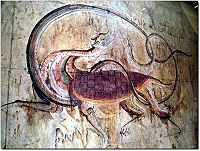
Painting
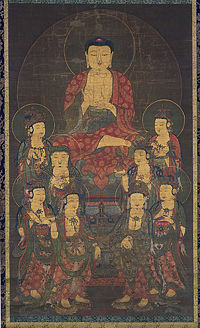
The earliest paintings found on the Korean peninsula are petroglyphs of prehistoric times. With the arrival of Buddhism from China, different techniques were introduced. These techniques quickly established themselves as the mainstream techniques, but indigenous techniques still survived.
There is a tendency towards naturalism with subjects such as realistic landscapes, flowers and birds being particularly popular. Ink is the most common material used, and it is painted on mulberry paper or silk.
In the 18th century indigenous techniques were advanced, particularly in calligraphy and seal engraving.
Arts are both influenced by tradition and realism in North Korea. For example, Han’s near-photographic "Break Time at the Ironworks" shows muscular men dripping with sweat and drinking water from tin cups at a sweltering foundry. Son’s "Peak Chonnyo of Mount Kumgang" is a classical Korean landscape of towering cliffs shrouded by mists (source : "The New York Times", [1]).
- See also: Korean art
Crafts
There is a unique set of handicrafts produced in Korea. Most of the handicrafts are created for a particular everyday use, often giving priority to the practical use rather than aesthetics. Traditionally, metal, wood, fabric, laquerware and earthenware were the main materials used, but later glass, leather or paper have sporadically been used.
Ancient handicrafts, such as red and black pottery, share similarities with pottery of Chinese cultures along the Yellow River. The relics found of the Bronze Age, however, are distinctive and more elaborate.
Many sophisticated and elaborate handicrafts have been excavated, including gilt crowns, patterned pottery, pots or ornaments. During the Goryeo period the use of bronze was advanced. Brass, that is copper with one third zinc, has been a particularly popular material. The dynasty, however, is renowned for its use of celadon ware.
During the Joseon period popular handicrafts were made of porcelain and decorated with blue painting. Woodcraft was also advanced during that period. This led to more sophisticated pieces of furniture, including wardrobes, chests, tables or drawers.
Ceramics
The use of earthenware on the Korean peninsula goes back to the Neolithic Age. The history of Korean Ceramics is long and includes both Korean pottery a later development after the traditional use of coils and hammered clay to create early votive and sculptural artifacts. During the Three Kingdoms period, pottery was advanced in Silla. The pottery was fired using a deoxidizing flame, which caused the distinctive blue grey celadon colour. The surface was embossed with various geometrical patterns.
In the Goryeo period jade green celadon ware became more popular. In the 12th century sophisticated methods of inlaying were invented, allowing more elaborate decorations in different colours.
White porcelain became popular in the 15th century. It soon overtook celadon ware. White porcelain was commonly painted or decorated with copper.
With the Japanese invasions of Korea in the 16th century, many leading potters were kidnapped to Japan where they profoundly influenced Japanese ceramics. Many leading Japanese pottery families today can trace their art and ancestry to these Korean potters.[2] [3] [4]
In the mid Joseon period (late 17th century) blue-and-white porcelain became popular. Designs were painted in cobalt blue on white porcelain. With the growth of Japan's hegemony on the peninsula towards the end of the 19th century the tradition of porcelain largely declined in favour of Japanese imports.
Lifestyle
Houses
Sites of residence are traditionally selected using geomancy. It is believed that any topographical configuration generates invisible forces of good or ill (gi). The negative and positive energies (yin and yang) must be brought into balance.
A house should be built against a hill and face south to receive as much sunlight as possible. This orientation is still preferred in modern Korea. Geomancy also influences the shape of the building, the direction it faces and the material it is built of.
Traditional Korean houses can be structured into an inner wing (anchae) and an outer wing (sarangchae). The individual layout largely depends on the region and the wealth of the family. Whereas aristocrats used the outer wing for receptions, poorer people kept cattle in the sarangchae. The wealthier a family, the larger the house. However, it was forbidden to any family except for the king to have a residence of more than 99 kan. A kan is the distance between two pillars used in traditional houses.
The inner wing normally consisted of a living room, a kitchen and a wooden-floored central hall. More rooms may be attached to this. Poorer farmers would not have any outer wing. Floor heating (ondol) has been used in Korea for centuries. The main building materials are wood, clay, tile, stone and thatch. Because wood and clay were the most common materials used in the past not many old buildings have survived into present times.
Gardens
The principles of temple gardens and private gardens are the same. They generally resemble gardens in China and Japan. This is so, because gardening in East Asia is heavily influenced by Taoism. Taoism emphasizes nature and mystery, paying great attention to the details of the layout. In contrast to Japanese and Chinese gardens, traditional Korean gardens avoid artificialities.
The lotus pond is an important feature in the Korean garden. If there is a natural stream, often a pavilion is built next to it, allowing the pleasure of watching the water. Terraced flower beds are a common feature in traditional Korean gardens.
The Poseokjeong site near Gyeongju was built in the Silla period. It highlights the importance of water in traditional Korean gardens. The garden of Poseokjeong features an abalone-shaped watercourse. During the last days of the Silla kingdom, the king's guest would sit along the watercourse and chat while wine cups were floated during banquets.
Dress
The traditional dress known as hanbok (known as joseonot in the DPRK) has been worn since ancient times. The hanbok consists of a shirt (jeogori) and pants (baji). The traditional hat is called gwanmo and special meaning is attached to this piece of clothing.
According to social status, Koreans used to dress differently, making clothing an important mark of social rank. Impressive, but sometimes cumbersome, costumes were worn by the ruling class and the royal family. Jewelry was also used to distance themselves from the ordinary people.
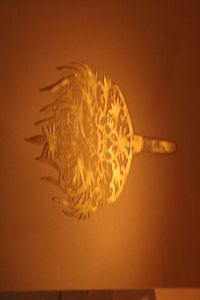
Common people were often restricted to un-dyed plain clothes. This everyday dress underwent relatively few changes during the Joseon period. The basic everyday dress was shared by everyone, but distinctions were drawn in official and ceremonial clothes.
During the winter people wore cotton-wadded dresses. Fur was also common. Because ordinary people normally wore undyed materials, the people were sometimes referred to as the white-clad folk.
Hanbok are classified according to their purposes: everyday dress, ceremonial dress and special dress. Ceremonial dresses are worn on formal occasions, including a child's first birthday, a wedding or a funeral. Special dresses are made for purposes such as shamans, officials.
Today the hanbok is still sometimes worn during formal occasions. The everyday use of the dress, however, has been lost.
Cuisine
Rice is the staple food of Korea. Having been an almost exclusively agricultural country until recently, the essential recipes in Korea are shaped by this experience. The main crops in Korea are rice, barley and beans, but many supplementary crops are used. Seafood is important, given that the country is bordered by the sea on three sides.
Fermented recipes were also developed in early times. These include pickled fish and pickled vegetables. This kind of food provides essential proteins and vitamins during the winter.
A number of menus have been developed. These can be divided into ceremonial foods and ritual foods. Ceremonial foods are used when a child reaches 100 days, at the first birthday, at a wedding ceremony, and the sixtieth birthday. Ritual foods are used at funerals, at ancestral rites, shaman's offerings and as temple food.
Temple food is distinguished as it does not use the common five strong-flavoured ingredients of Korean cuisine (garlic, spring onion, wild rocambole, leek and ginger), nor meat.
For ceremonies and rituals rice cakes are vital. The colouring of the food and the ingredients of the recipes are matched according to yin and yang, trying to reach a balance.
Today, traditional court cuisine is available to the whole population. In the past vegetable dishes were essential, but meat consumption has increased. Traditional dishes include ssambap, bulgogi, sinseollo, kimchi, bibimbap and gujeolpan.
Tea
- Main article: Korean tea
Tea in Korea dates back over 2000 years.[citation needed]It was part of a number of worship recipes, hoping that the good scents would reach the heavenly gods. Tea was introduced in Korea, when Buddhism was introduced from China, and later gave rise to the Korean Tea Ceremony.
Originally tea was used for ceremonial purposes or as part of traditional herbal medicine. Green tea, as it is used in China and Japan, is not the only kind of tea drunk in Korea. A great number of teas made of fruits, leaves, seeds or roots are enjoyed. Five tastes of tea are distinguished in Korea: the sweet, sour, salty, bitter, and pungent tastes.
Festivals of the lunar calendar
The Korean calendar is divided into 24 turning points (jeolgi), each lasting about 15 days. The lunar calendar was the timetable for the agrarian society in the past, but is vanishing in the modern Korean lifestyle.
Traditional festivals, however, are still celebrated according to the lunar calendar. The biggest festival is the traditional lunar New Year's Day (seollal or gujeong). Other important festivals include the first full moon (jeongwol daeboreum), the spring festival (dano) and the harvest festival (chuseok).
Older generations still celebrate their birthdays according to the lunar calendar.
Traditional holidays
| Festival | Significance | Events | Date (lunar) | Food |
|---|---|---|---|---|
| Seollal | Lunar New Year's Day | An ancestral service is offered before the grave of the ancestors, New Year's greetings are exchanged with family, relatives and neighbours; bows to elders (sebae), yutnori. See also Chinese New Year and East Asian age reckoning | Day 1 of Month 1 | sliced rice cake in soup (tteokguk), honey cakes (yakwa). |
| Daeboreum | First full moon | Greeting of the moon (dalmaji), kite-flying, talisman burning to ward evil spirits (aengmagi taeugi), bonfires (daljip taegi) | Day 15 of Month 1 | rice boiled with five grains (ogokbap), nut eating (bureom), wine drinking (gwibalgisul) |
| Meoseumnal | Festival for servants | Housecleaning, coming of age ceremony, fishermen's shaman rite (yeongdeunggut) | Day 1 of Month 2 | stuffed pine-flavoured rice cakes (songpyeon) |
| Samjinnal | Migrant swallows return | Leg fighting, fortune telling | Day 3 of Month 3 | Azalea wine (dugyonju), pancake (dungyeon hwajeon) |
| Hansik | Beginning of farming season | Visit to ancestral grave for offering rite, and cleaning and maintenance. See also Ching Ming Festival | Day 105 after winter solstice | cold food only: mugwort cake (ssuktteok), mugwort dumplings (ssukdanja), mugwort soup (ssuktang) |
| Chopail | Buddha's birthday | Lantern festival | Day 8 of Month 4 | rice cake (jjinddeok), flower cake (hwajeon) |
| Dano | Spring festival | Washing hair with iris water, ssireum, swinging, giving fans as gifts | Day 5 of Month 5 | rice cake with herbs (surichitteok), herring soup (junchiguk) |
| Yudu | Water greeting | Water greeting, washing hair to wash away bad luck | Day 15 of Month 6 | Five coloured noodles (yudumyeon), rice dumplings (sudan) |
| Chilseok | Meeting day of Gyeonwoo and Jiknyeo, in Korean folk tale | Fabric weaving | Day 7 of Month 7 | wheat pancake (milijeonbyeong), rice cake with red beans (sirutteok) |
| Baekjung | Worship to Buddha | Worship to Buddha | Day 15 of Month 7 | mixed rice cake (seoktanbyeong) |
| Chuseok | Harvest festival | Visit to ancestral grave, ssireum, offering earliest rice grain (olbyeosinmi), circle dance (ganggang suwollae) | Day 15 of Month 8 | pine flavoured rice cake stuffed with chestnuts, sesame or beans (songpyeon), taro soup (torantang) |
| Jungyangjeol | Migrant sparrows leave | Celebrating autumn with poetry and painting, composing poetry, enjoying nature. See also Chung Yeung Festival | Day 9 of Month 9 | chrysanthemum pancake (gukhwajeon), roe (eoran), honey citron tea (yujacheong) |
| Dongji | Winter Solstice | Rites to dispel bad spirits | Around December 22 in the solar calendar | redbean soup with rice dumplings (patjuk) |
| Seotdal Geumeum | New Year's Eve | Staying up all night long with all doors open to receive ancestral spirits | Day 31 of Month 12 | mixed rice with vegetables (bibimbap), bean power rice cakes (injeolmi), traditional biscuits (hangwa) |
There is also a number of regional festivals, celebrated according to the lunar calendar. See also Public holidays in North Korea and Public holidays in South Korea.
Games
There are a number of board games played in Korea. Baduk is the Korean name for what is known as Go in English. This game is particularly popular with middle-aged and elderly men. It has a similar status as has chess in Western cultures. There is a Korean version of chess called Janggi, based on an old version of Chinese chess. Yut is a popular family board game enjoyed throughout the country, especially during holidays.
No longer commonly played, Chajeon Nori is a traditional game involving two teams of villagers in a giant jousting match.
Sauna
The only Korean Sauna in Europe opened at Bad Sodens Sodeniatherme (near Frankfurt/Main). One borrows the usual cotton-outfit for the up to 80 degree "Löß-Lehm"-wood cabines with a also ((hopefully)) healing stone floor (made out of Jade). Also Koreans from other European countries travel to this Sauna, to stay over night with their families (as in Korea usual: 24 hours opened).
World Heritage sites
There are a number of designated UNESCO World Heritage sites in Korea.
Jongmyo Shrine
The Jongmyo Shrine was added to the UNESCO World Heritage Site list in 1995. The shrine is dedicated to the spirits of the ancestors of the royal family of the Joseon Dynasty. It is heavily influenced by Confucian tradition. An elaborate performance of ancient court music (with accompanying dance) known as Jongmyo jeryeak is performed there each year.
When it was built in 1394 is was thought to be one of the longest buildings in Asia, if not the longest. There are 19 memorial tablets of kings and 30 of their queens, placed in 19 chambers. The shrine was burnt to the ground during the Japanese invasion in 1592, but rebuilt by 1608.
Changdeokgung
Changdeokgung is also known as the palace of illustrious virtue. It was built in 1405, burnt to the ground during the Japanese invasion in 1592 and reconstructed in 1609. For more than 300 years Changdeokgung was the site of the royal seat. It is located in Seoul
The surroundings and the palace itself are well matched. Some of the trees behind the palace are now over 300 years old. Changdeokgung was added to the UNESCO World Heritage list in 1997.
Bulguksa
Bulguksa is also known as the temple of the Buddha Land and home of the Seokguram Grotto. The temple was constructed in 751 and consists of a great number of halls. There are two pagodas placed in the temple.
The Seokguram grotto is a hermitage of the Bulguksa temple. It is a granite sanctuary. In the main chamber a Buddha statue is seated. The temple and the grotto were added to the UNESCO World Heritage list in 1995.
Tripitaka Koreana and Haeinsa
Haeinsa is a large temple in the South Gyeongsang province. It was built in 802 and home to the Tripitaka Koreana wood blocks. The carving of these wood blocks was initiated in 1236 and only completed in 1251. The wood blocks are testimony to the pious devotion of king and his people.
The word Tripitaka is Sanskrit and stands for three baskets, referring to the Buddhist laws of aesthetics. The Tripitaka Koreana consists of 81'258 wood blocks and is the largest collection of Buddhist scripts. Amazingly there is no trace of errata or omission on any of the wood blocks. The Tripitaka Koreana is widely considered as the most beautiful and accurate Buddhist canon carved in Chinese characters.
The site was added to the UNESCO World Heritage list in 1995.
Hwaseong
Hwaseong is the fortification of the city Suwon south of Seoul in South Korea. Its construction was completed in 1796 and it features all the latest features of Korean fortification known at the time.
The fortress covers both flat land and hilly terrain, something rarely seen in East Asia. The walls are 5.52 kilometres long and there are 41 extant facilities along the perimeter. These include four cardinal gates, a floodgate, four secret gates and a beacon tower.
Hwaseong was added to the UNESCO World Heritage list in 1997.
Gochang, Hwasun and Ganghwa sites
The sites of Gochang, Hwasun and Ganghwa were added to the UNESCO list of World Heritage in 2000. These sites are home to prehistoric graveyards which contain hundreds of different megaliths. These megaliths are gravestones which were created in the 1st century B.C.E. out of large blocks of rock. Megaliths can be found around the globe, but nowhere in such a concentration as in the sites of Gochang, Hwasun and Ganghwa.
Gyeongju Area
The historic area around Gyeongju was added to the UNESCO list of World Heritage in 2000. Gyongju was the capital of the Silla kingdom. The tombs of the Silla rulers can still be found in the centre of the city. These tombs took the shape of rock chambers buried in an earthen hill, sometimes likened with the pyramids. The area around Gyeongju, in particular on the Namsan mountain, is scattered with hundreds of remains from the Silla period. Poseokjeong is one of the most famous of these sites, but there is a great number of Korean Buddhist art, sculptures, reliefs, pagodas and remains of temples and palaces mostly built in the 7th and 10th century.
Complex of Goguryeo Tombs
The Complex of Goguryeo Tombs lies in Pyongyang, Pyong'an South Province, and Nampo City, South Hwanghae Province, North Korea. In July 2004 it became the first UNESCO World Heritage site north of the 38th parallel.
The site consists of 63 individual tombs from the later Goguryeo, one of the Three Kingdoms of Korea. It was founded around northern Korea and Manchuria around 32 B.C.E., and the capital was moved to Pyongyang in 427. This kingdom dominated the region between the 5th and 7th century AD.
See also
- List of Korea-related topics
- National treasures of South Korea
- UNESCO World Heritage sites
- Traditional Korean thought
- East Asian age reckoning
- Marriage in South Korea
| ||||||||
Credits
New World Encyclopedia writers and editors rewrote and completed the Wikipedia article in accordance with New World Encyclopedia standards. This article abides by terms of the Creative Commons CC-by-sa 3.0 License (CC-by-sa), which may be used and disseminated with proper attribution. Credit is due under the terms of this license that can reference both the New World Encyclopedia contributors and the selfless volunteer contributors of the Wikimedia Foundation. To cite this article click here for a list of acceptable citing formats.The history of earlier contributions by wikipedians is accessible to researchers here:
The history of this article since it was imported to New World Encyclopedia:
Note: Some restrictions may apply to use of individual images which are separately licensed.
